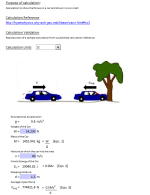Car Crash Analysis

Description
Purpose of calculation:
Calculation to show the forces on a car and driver in a car crash
Calculation Reference
http://hyperphysics.phy-astr.gsu.edu/hbase/carcr.html#cc3
Calculation Validation
Reproduction of a sample calculation from a published calculation reference.
Calculation Reference
Mechanics
Newtonian Mechanics
Dynamics
Impact
During a car crash, various forces act on both the car and the driver. Understanding these forces helps engineers design safer vehicles and can also illustrate the importance of wearing seat belts and other safety devices. Here are some of the key forces involved in a car crash:
-
Inertia: Inertia is the property of an object to maintain its state of motion, whether at rest or in motion, unless acted upon by an external force. When a car is moving, both the vehicle and its occupants have a certain amount of kinetic energy due to their mass and velocity. In a crash, the car may come to a sudden stop, but the occupants' inertia will keep them moving at the initial velocity until an external force (e.g., a seatbelt, airbag, or the car's interior) acts on them, causing them to decelerate.
-
Deceleration: Deceleration is the rate at which an object slows down. In a car crash, the car and its occupants experience a rapid deceleration due to the collision. This deceleration causes a large force to be exerted on both the car and its occupants. The faster the deceleration, the greater the force.
-
Impact force: When a car collides with another object, an impact force is generated. This force is responsible for the deformation of the car's structure and the absorption of kinetic energy. The car's crumple zones, bumpers, and other structural elements are designed to absorb and dissipate this energy, reducing the force transmitted to the occupants.
-
Restraint forces: Restraint devices like seat belts and airbags are essential in a car crash. They apply forces to the occupants to counteract their inertia and decelerate them more gradually, reducing the risk of injury. Seat belts distribute the restraining force across the stronger parts of the body, like the chest and pelvis, while airbags provide additional cushioning to prevent direct contact with the car's interior.
-
G-forces: During a car crash, occupants can experience significant g-forces (gravitational forces) as they are rapidly decelerated. High g-forces can cause injuries or even death, depending on the severity of the crash and the effectiveness of safety features in the car.
To summarize, the main forces acting on a car and driver during a crash are inertia, deceleration, impact force, restraint forces, and g-forces. Vehicle safety features, such as crumple zones, seat belts, and airbags, are designed to manage these forces and protect occupants in the event of an accident.
Calculation Preview
Full download access to any calculation is available to users with a paid or awarded subscription (XLC Pro).
Subscriptions are free to contributors to the site, alternatively they can be purchased.
Click here for information on subscriptions.


